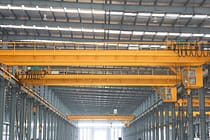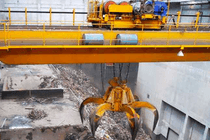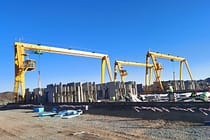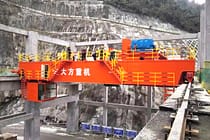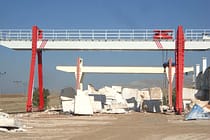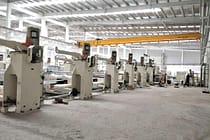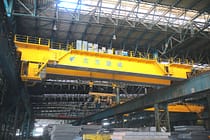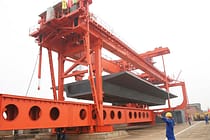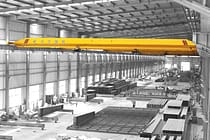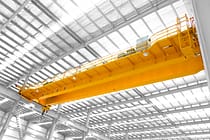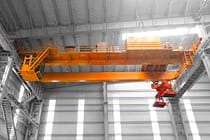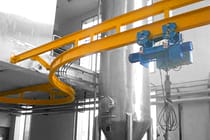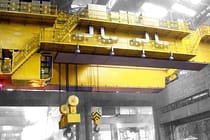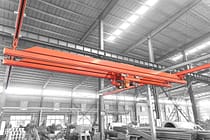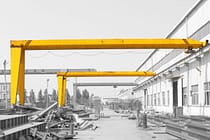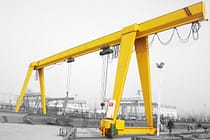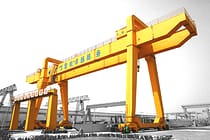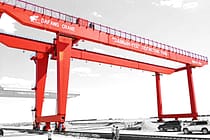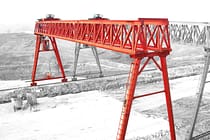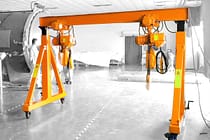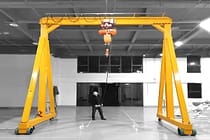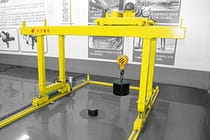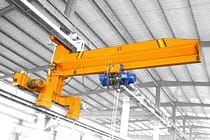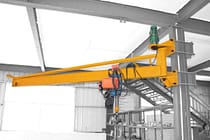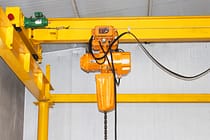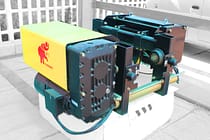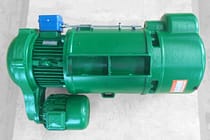Ανάλυση εξαρτημάτων και λειτουργιών γερανογέφυρας: Ένας λεπτομερής οδηγός για την κατανόηση των βασικών εξαρτημάτων
Πίνακας περιεχομένων
Αν θέλετε να κατανοήσετε τα μέρη μιας γερανογέφυρας, αυτός ο οδηγός είναι για εσάς. Εξηγεί τα κύρια εξαρτήματα, αξεσουάρ και συγκροτήματα μιας τυπικής γερανογέφυρας. Είτε είστε χειριστής, εργάτης συντήρησης είτε νέος στον κλάδο, αυτό το άρθρο θα σας βοηθήσει να κατανοήσετε τη λειτουργία και τη σημασία κάθε εξαρτήματος για καθημερινή χρήση, συντήρηση και αντιμετώπιση προβλημάτων.
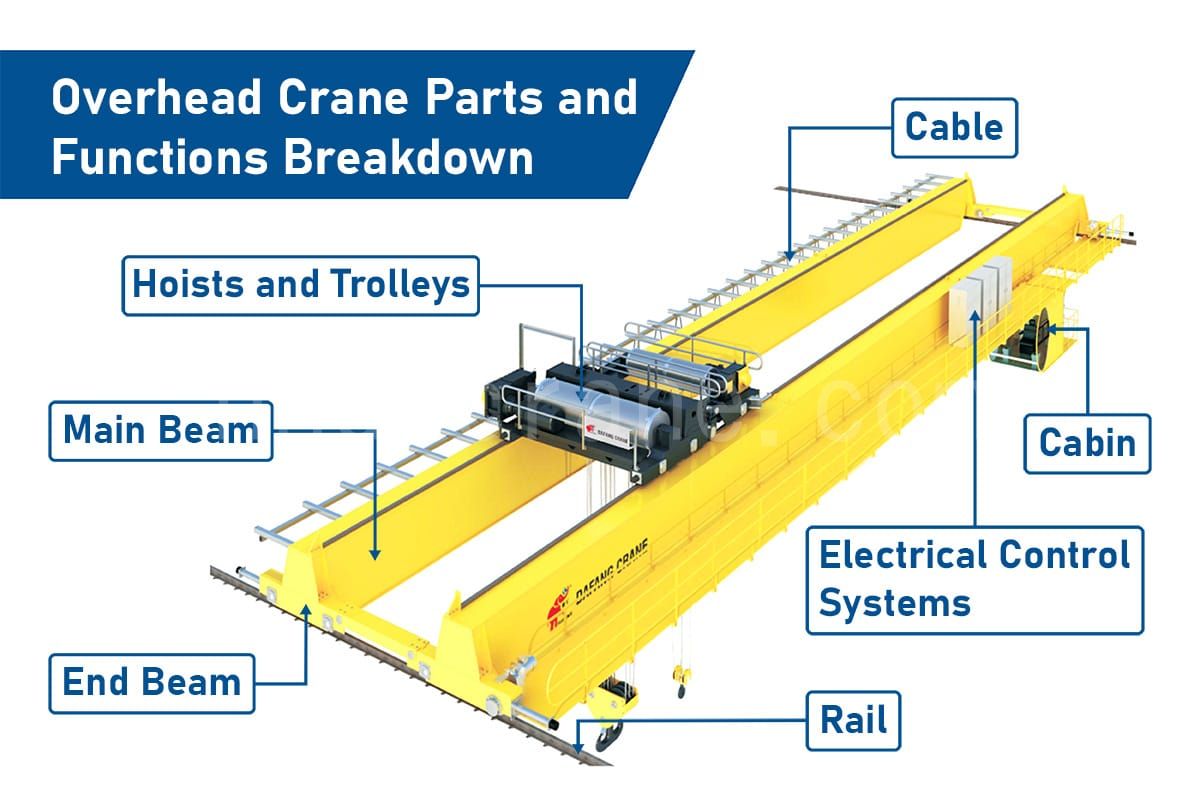
Πλαίσιο γερανού
Κύρια δοκός
Η κύρια δοκός είναι η βασική φέρουσα δομή ενός γερανού. Συνήθως κατασκευάζεται από χάλυβα υψηλής αντοχής και έχει σχεδιαστεί για να αντέχει στην κάμψη και τη στρέψη, εξασφαλίζοντας σταθερότητα υπό βαριά φορτία. Η κύρια λειτουργία της είναι να στηρίζει το φορείο και το γάντζο, και να παρέχει μια τροχιά για να κινείται το φορείο ομαλά κατά μήκος της δοκού για ακριβή τοποθέτηση του φορτίου.
Τελική δοκός
Η ακραία δοκός συνδέει και τα δύο άκρα της κύριας δοκού και υποστηρίζει ολόκληρη τη δομή του γερανού. Συνήθως βρίσκεται και στις δύο πλευρές του γερανού και επιτρέπει σε ολόκληρο το σύστημα να κινείται κατά μήκος των σιδηροτροχιών του διαδρόμου. Οι ακραίες δοκοί είναι εξοπλισμένες με μονάδες κίνησης ή τροχούς κίνησης και συνδέονται με τον μηχανισμό κίνησης του γερανού, εξασφαλίζοντας σταθερή κίνηση κατά μήκος της τροχιάς. Ο σχεδιασμός τους επικεντρώνεται στην αντοχή και την ανθεκτικότητα υπό υψηλά φορτία, παίζοντας βασικό ρόλο στη συνολική σταθερότητα και ευελιξία του γερανού.
Καμπίνα
ο καμπίνα είναι το σημείο όπου ο χειριστής ελέγχει τον γερανό. Συνήθως αναρτάται κάτω από την κύρια δοκό ή τοποθετείται σε θέση με ανεμπόδιστη θέα στον χώρο εργασίας. Η καμπίνα έχει σχεδιαστεί για καλή ορατότητα και ασφάλεια. Είναι εξοπλισμένη με κονσόλα ελέγχου ή ελεγκτή έκκεντρου για ακριβείς λειτουργίες ανύψωσης και κίνησης. Για να διασφαλιστεί η άνεση του χειριστή, η καμπίνα συχνά περιλαμβάνει κλιματισμό, εξαερισμό και εργονομικό κάθισμα και διάταξη για τη μείωση της κόπωσης και τη βελτίωση της ασφάλειας και της αποδοτικότητας. Η πρόσβαση στην καμπίνα παρέχεται συνήθως μέσω κάθετων ή κεκλιμένων σκαλών που συνδέονται με το διάδρομο.
Μηχανισμός μετακίνησης γερανού

Τροχοί
Τροχοί γερανού είναι βασικά εξαρτήματα του μηχανισμού κίνησης, που συνήθως τοποθετούνται στο κάτω μέρος των ακραίων δοκών. Κυκλώνουν κατά μήκος των σιδηροτροχιών και υποστηρίζουν ολόκληρο το βάρος του γερανού. Υπάρχουν δύο κύριοι τύποι: κινητήριοι τροχοί, οι οποίοι προωθούν τον γερανό κατά μήκος των σιδηροτροχιών, και ρελαντί, οι οποίοι βοηθούν στην ομαλή κίνηση. Αυτοί οι τροχοί είναι συνήθως κατασκευασμένοι από κράμα χάλυβα υψηλής αντοχής για αντοχή στη φθορά και την κρούση υπό βαριά φορτία και συχνή κίνηση. Ο σχεδιασμός τους λαμβάνει υπόψη τη φθορά των σιδηροτροχιών και περιλαμβάνει ακριβή κατεργασία και ρύθμιση για να διασφαλίζεται η ομαλή λειτουργία, ο χαμηλός θόρυβος και η μεγάλη διάρκεια ζωής τόσο για τους τροχούς όσο και για τις σιδηροτροχιές.
Μοτέρ
Ο κινητήρας κίνησης τροφοδοτεί την οριζόντια κίνηση της γέφυρας του γερανού και του τρόλεϊ κατά μήκος των σιδηροτροχιών. Μετατρέπει την ηλεκτρική ενέργεια σε μηχανική κίνηση, εξασφαλίζοντας ακριβή και ομαλή κίνηση. Συνήθως σε συνδυασμό με κιβώτιο ταχυτήτων, η περιστροφή υψηλής ταχύτητας του κινητήρα μειώνεται σε χαμηλότερη ταχύτητα με υψηλότερη ροπή, παρέχοντας επαρκή πρόσφυση και σταθερότητα κατά την κίνηση του γερανού.
Περιστέλλων
Ο μειωτήρας είναι ένα βασικό εξάρτημα μετάδοσης κίνησης μεταξύ του κινητήρα και των τροχών. Μειώνει την υψηλή ταχύτητα εξόδου του κινητήρα σε μια χαμηλή ταχύτητα και υψηλή ροπή, κατάλληλη για σταθερή λειτουργία του γερανού. Μέσω πολλαπλών σταδίων μετάδοσης, εξασφαλίζει επαρκή δύναμη έλξης για να κινείται ο γερανός ομαλά κατά μήκος των σιδηροτροχιών. Κατασκευασμένος από υλικά υψηλής αντοχής και αντοχής στη φθορά, ο μειωτήρας έχει σχεδιαστεί για μεγάλη διάρκεια ζωής υπό συχνές εκκινήσεις, στάσεις και μεταβαλλόμενα φορτία. Η ακριβής σχέση μετάδοσης εξασφαλίζει ομαλή εκκίνηση, σταμάτημα και τοποθέτηση.
Φρένο
ο φρένο είναι μια κρίσιμη συσκευή ασφαλείας που διασφαλίζει ότι ο γερανός σταματάει αξιόπιστα στις ράγες. Συνήθως τοποθετείται στον άξονα εξόδου του κινητήρα και λειτουργεί μέσω μηχανικής ή ηλεκτρομαγνητικής δύναμης. Όταν απαιτείται πέδηση, ασκεί γρήγορα δύναμη για να σταματήσει με ακρίβεια τον γερανό και να αποτρέψει την ανεξέλεγκτη κίνηση που προκαλείται από αδράνεια. Κατασκευασμένο από υλικά ανθεκτικά στη φθορά, το φρένο έχει σχεδιαστεί για βαριές συνθήκες και συχνές εκκινήσεις-σταματήσεις, συχνά με προστασία υπερθέρμανσης και αυτόματη ρύθμιση για τη διατήρηση αποτελεσματικού φρεναρίσματος κατά τη μακροχρόνια χρήση.
Σύζευξη
Ο σύνδεσμος συνδέει τον κινητήρα με το κιβώτιο ταχυτήτων ή το κιβώτιο ταχυτήτων με τους τροχούς. Μεταδίδει ροπή και προσαρμόζεται σε μικρές αποκλίσεις ευθυγράμμισης μεταξύ των συνδεδεμένων αξόνων. Σε εφαρμογές γερανών, οι σύνδεσμοι απορροφούν επίσης κραδασμούς και κραδασμούς κατά τη λειτουργία, προστατεύοντας τα εξαρτήματα του κιβωτίου ταχυτήτων και εξασφαλίζοντας ομαλότερη παροχή ισχύος.
Μηχανισμός ανύψωσης γερανού (ανυψωτήρες και καρότσια)
Στις εναέριες γερανούς, οι συνήθεις συσκευές ανύψωσης περιλαμβάνουν ανυψωτήρες και ανοιχτά καρότσια βαρούλκων. Γερανοί μονής δοκού συνήθως χρησιμοποιούν ανυψωτικά μηχανήματα, ενώ διπλοί γερανοί δοκών μπορούν να επιλέξουν είτε ηλεκτρικούς ανυψωτήρες είτε ανοιχτά καρότσια βαρούλκου.
Οι εναέριοι γερανογέφυρες σε συνδυασμό με καρότσια τοποθετούνται στην κύρια δοκό του γερανού και μπορούν να χρησιμοποιηθούν για κάθετη ανύψωση και οριζόντια μετακίνηση φορτίων. Οι συνηθισμένοι τύποι ανυψωτικών περιλαμβάνουν χειροκίνητα βαρούλκα αλυσίδας, ηλεκτρικά βαρούλκα από συρματόσχοινο και ηλεκτρικά βαρούλκα αλυσίδας. Τα ηλεκτρικά βαρούλκα είναι κατάλληλα για υψηλής απόδοσης και συχνές εργασίες, παρέχοντας μεγαλύτερη δύναμη ανύψωσης και ταχύτερη απόδοση εργασίας. Τα χειροκίνητα βαρούλκα χρησιμοποιούνται για ελαφρά φορτία ή ακριβείς εργασίες, με απλή λειτουργία και χαμηλό κόστος συντήρησης. Τα ηλεκτρικά βαρούλκα από συρματόσχοινο έχουν μεγαλύτερη ταχύτητα και ομαλότερη, πιο αθόρυβη λειτουργία, κυριαρχώντας στην αγορά για ανυψωτικές ικανότητες 10 τόνων και άνω. Σε σύγκριση με τα ηλεκτρικά βαρούλκα από συρματόσχοινο, τα ηλεκτρικά βαρούλκα αλυσίδας έχουν πιο ανθεκτικές αλυσίδες, καταλαμβάνουν λιγότερο χώρο και είναι πιο οικονομικά, συνήθως χρησιμοποιούνται για ελαφριές εφαρμογές κάτω των 5 τόνων.
Τα ανοιχτά καρότσια βαρούλκου εγκαθίστανται ανάμεσα σε δύο κύριες δοκούς και χρησιμοποιούν σύστημα τροχαλιών και συρματόσχοινο για την ανύψωση αντικειμένων. Είναι εξοπλισμένα με αποδοτικούς κινητήρες και μειωτήρες, παρέχοντας ισχυρή πρόσφυση και σταθερή ταχύτητα ανύψωσης. Σε σύγκριση με τις παραδοσιακές συσκευές ανύψωσης τύπου ανυψωτικού, τα ανοιχτά καρότσια βαρούλκου μπορούν να χειριστούν βαρύτερα φορτία και υψηλότερες απαιτήσεις ανύψωσης.
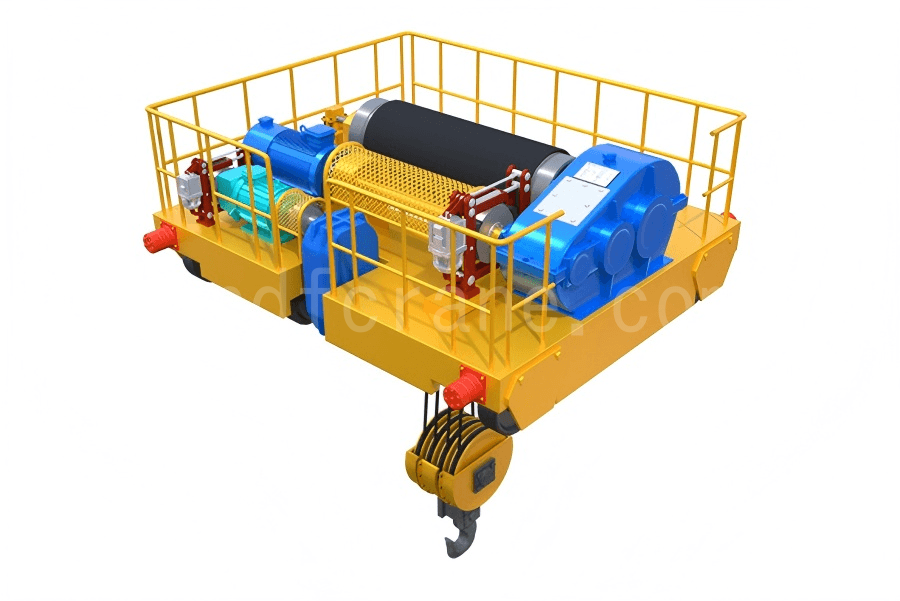
Τα κύρια εξαρτήματα ενός μηχανισμού ανύψωσης γερανού περιλαμβάνουν:
στάχυα
Οι τροχαλίες είναι κρίσιμα εξαρτήματα στον μηχανισμό ανύψωσης που χρησιμοποιείται για την καθοδήγηση του συρματόσχοινου. Αλλάζοντας την κατεύθυνση και την ικανότητα φέρουσας ικανότητας του συρματόσχοινου, οι τροχαλίες μοιράζονται αποτελεσματικά το φορτίο ανύψωσης και ενισχύουν την ικανότητα ανύψωσης του γερανού. Υπάρχουν δύο τύποι τροχαλιών: οι σταθερές τροχαλίες, οι οποίες αλλάζουν την κατεύθυνση της κίνησης του συρματόσχοινου, και οι κινητές τροχαλίες, οι οποίες κινούνται με το φορτίο, μειώνοντας έτσι την απαιτούμενη δύναμη έλξης.
Η εξωτερική άκρη μιας τροχαλίας έχει σχεδιαστεί με μια αυλάκωση για να συγκρατεί σταθερά το συρματόσχοινο και να αποτρέπει την ολίσθηση ή τη φθορά. Πολλαπλές τροχαλίες διατεταγμένες σε ένα μπλοκ μπορούν να πολλαπλασιάσουν τη φέρουσα ικανότητα του γερανού, μειώνοντας παράλληλα την απαιτούμενη ισχύ του κινητήρα. Τα μπλοκ τροχαλίας είναι βασικά εξαρτήματα για την επίτευξη αποτελεσματικών εργασιών ανύψωσης.
Γάντζοι
Γάντζοι γερανού Χρησιμοποιούνται για την προσάρτηση και μεταφορά φορτίων, συνήθως κατασκευασμένα από κράμα χάλυβα υψηλής αντοχής και εξοπλισμένα με μάνδαλα ασφαλείας για την αποφυγή τυχαίας απελευθέρωσης φορτίου κατά τη λειτουργία. Τα άγκιστρα συνήθως σχεδιάζονται ως μονά ή διπλά άγκιστρα. Τα μονά άγκιστρα είναι κατάλληλα για ελαφρά έως μεσαία φορτία, ενώ τα διπλά άγκιστρα βοηθούν στην πιο ομοιόμορφη κατανομή των βαρύτερων φορτίων, βελτιώνοντας τη σταθερότητα και την ασφάλεια. Επιπλέον, τα άγκιστρα μπορούν να περιστραφούν 360 μοίρες, διευκολύνοντας τη διαχείριση φορτίου από διαφορετικές γωνίες και ενισχύοντας την ευελιξία λειτουργίας. Εκτός από τα άγκιστρα, οι γερανογέφυρες μπορούν επίσης να χρησιμοποιήσουν άλλα εξαρτήματα ανύψωσης, όπως κουβάδες αρπάγης και ηλεκτρομαγνητικούς ανυψωτήρες ανάλογα με την εφαρμογή.
Κινητήρες
Ο κινητήρας ανύψωσης είναι το βασικό εξάρτημα που παρέχει ανυψωτική ισχύ. Συνήθως έχει σχεδιαστεί για υψηλή ροπή και χαμηλή ταχύτητα με υψηλή ακρίβεια, για να καλύπτει τις απαιτήσεις ανύψωσης και κατεβάσματος βαρέων φορτίων. Ο κινητήρας πρέπει να παρέχει ισχυρή ροπή εκκίνησης για να επιτρέπει την ομαλή εκκίνηση υπό φορτίο και επαρκή δύναμη ανύψωσης. Οι κινητήρες συχνά διαθέτουν μετατροπείς συχνότητας ή συστήματα ελέγχου ταχύτητας, επιτρέποντας στους χειριστές να ελέγχουν με ακρίβεια την ταχύτητα ανύψωσης, βελτιώνοντας την ακρίβεια τοποθέτησης και την ευελιξία λειτουργίας.
Μειωτήρες
Ο μειωτήρας συνδέει τον κινητήρα και το τύμπανο, χρησιμεύοντας ως κρίσιμο εξάρτημα μετάδοσης κίνησης. Η κύρια λειτουργία του είναι να μετατρέπει την υψηλή ταχύτητα περιστροφής του κινητήρα σε απόδοση χαμηλής ταχύτητας και υψηλής ροπής, κατάλληλη για την ανύψωση βαρέων φορτίων, εξασφαλίζοντας ομαλή και ακριβή ανύψωση φορτίου. Οι μειωτήρες συνήθως χρησιμοποιούν κιβώτιο ταχυτήτων πολλαπλών σταδίων, μειώνοντας προοδευτικά την ταχύτητα ενώ αυξάνουν τη ροπή για να παρέχουν την απαραίτητη ισχύ κατά τις εργασίες ανύψωσης.
Φρένα
Τα φρένα στον μηχανισμό ανύψωσης ελέγχουν και συγκρατούν το φορτίο κατά την ανύψωση ή την κάθοδο, αποτρέποντας την ανεξέλεγκτη κάθοδο του φορτίου. Συνήθως εγκαθίστανται στον άξονα εξόδου του κινητήρα ή του μειωτήρα. Όταν η ανύψωση σταματήσει ή σε καταστάσεις έκτακτης ανάγκης, το φρένο ασκεί γρήγορα δύναμη για να διατηρήσει το φορτίο σταθερό στη θέση του, εξασφαλίζοντας την ασφάλεια λειτουργίας.
Τύμπανα
ο τύμπανο σχοινιού γερανού είναι το εξάρτημα γύρω από το οποίο τυλίγεται και ξετυλίγεται το συρματόσχοινο, ελέγχοντας την κατακόρυφη κίνηση του γάντζου ή άλλων εξαρτημάτων ανύψωσης. Η επιφάνεια του τυμπάνου έχει αυλακώσεις για να διατηρεί το συρματόσχοινο ευθυγραμμισμένο κατά την περιέλιξη, αποτρέποντας την ολίσθηση ή την επικάλυψη, γεγονός που βοηθά στην παράταση της διάρκειας ζωής του συρματόσχοινου και στη μείωση της φθοράς.
Τα βαρέλια συνδέονται με κινητήρες μέσω μειωτήρων για ακριβή έλεγχο ανύψωσης. Οι διαστάσεις τους, το βάθος αυλάκωσης και το βήμα τους βελτιστοποιούνται με βάση τις προδιαγραφές του συρματόσχοινου και το φορτίο σχεδιασμού του γερανού. Τα βαρέλια περιλαμβάνουν επίσης οδηγοί σχοινιών για να διατηρείται η ομαλή περιέλιξη και να αποτρέπεται το μπλέξιμο. Ο σωστός σχεδιασμός και η συντήρηση του τυμπάνου είναι κρίσιμα για την ομαλή λειτουργία του γερανού και την ασφαλή ανύψωση.
Συρματόσχοινα
Τα συρματόσχοινα είναι απαραίτητα εξαρτήματα που φέρουν και ανυψώνουν φορτία στον μηχανισμό ανύψωσης. Συνδέουν το γάντζο, το μπλοκ τροχαλίας και το τύμπανο, επιτρέποντας την ανύψωση και την κάθοδο με περιέλιξη στο τύμπανο. Τα συρματόσχοινα ποικίλλουν σε διάμετρο, αντοχή σε εφελκυσμό και αντοχή στη διάβρωση ανάλογα με την εφαρμογή του γερανού — οι εξωτερικοί γερανοί ενδέχεται να χρησιμοποιούν σχοινιά ανθεκτικά στη διάβρωση. Η φθορά, τα σπασμένα νήματα και η παραμόρφωση επηρεάζουν την ασφάλεια των συρματόσχοινων, επομένως η τακτική επιθεώρηση και συντήρηση είναι απαραίτητες για την εξασφάλιση ασφαλών και αξιόπιστων εργασιών ανύψωσης.
Ηλεκτρικά και Ελεγχόμενα Συστήματα Γερανογέφυρας
Το ηλεκτρικό σύστημα ελέγχου είναι σχετικά πολύπλοκο και αποτελείται κυρίως από τα ακόλουθα μέρη:
Μπάρα ζυγοστάθμισης
Ο ζυγός είναι η κύρια μέθοδος τροφοδοσίας για τους εναέριους γερανούς. Συνήθως εγκαθίσταται στη μία πλευρά του διαδρόμου γερανού και αποτελείται από μια σειρά παράλληλων αγώγιμων ραγών κατασκευασμένων από χαλκό ή αλουμίνιο. Ο ζυγός παρέχει συνεχώς ρεύμα στη γέφυρα και το φορείο καθώς κινούνται, διασφαλίζοντας ότι όλες οι ηλεκτρικές συσκευές λειτουργούν χωρίς διακοπή.
Το σύστημα ζυγών περιλαμβάνει ράγες, συλλέκτες και μονωτικές βάσεις. Οι συλλέκτες εγκαθίστανται στη γέφυρα ή στο τρόλεϊ, ολισθαίνοντας κατά μήκος της ράβδου ζυγών για να συλλέγουν ηλεκτρική ενέργεια και να τη μεταδίδουν στους κινητήρες και τις συσκευές ελέγχου του γερανού. Οι μονωτικές βάσεις στερεώνουν τη ράβδο ζυγών στη θέση της και την απομονώνουν από τη δομή για την αποφυγή διαρροών και την ασφάλεια.
Απαιτείται ακριβής ευθυγράμμιση κατά τον σχεδιασμό και την εγκατάσταση των ζυγών για να αποφευχθεί η κακή επαφή ή το άλμα των συλλεκτών, κάτι που θα μπορούσε να επηρεάσει τη σταθερότητα της ισχύος.
Καλώδιο τροφοδοσίας
Το τροφοδοτικό καλώδιο Παρέχει κυρίως σταθερό ηλεκτρικό ρεύμα στο ηλεκτρικό ανυψωτικό ή το καρότσι βαρούλκου του γερανού, στο σύστημα οδήγησης και στο σύστημα ελέγχου. Τα καλώδια συνήθως τοποθετούνται στο πλαίσιο ή το καρότσι του γερανού, καθοδηγούμενα από συρόμενες ράγες ή φορείς καλωδίων, επιτρέποντας στα καλώδια να κινούνται ελεύθερα με τη γέφυρα ή το καρότσι χωρίς να τραβιούνται ή να καταστρέφονται κατά τη λειτουργία.
Ελεγχος
Οι εναέριες γερανοί μπορούν να χρησιμοποιούν διάφορες μεθόδους ελέγχου. Οι κύριοι τύποι περιλαμβάνουν τον έλεγχο της καμπίνας χειριστή, τον τηλεχειρισμό και τον κρεμαστό έλεγχο:
- Έλεγχος Καμπίνας Χειριστή: Στον γερανό εγκαθίσταται μια ανεξάρτητη καμπίνα, συνήθως αναρτημένη κάτω από την κύρια δοκό ή κοντά στο φορείο. Ο χειριστής ελέγχει όλες τις λειτουργίες του γερανού (κίνηση γέφυρας, κίνηση φορείου και ανύψωση) από μέσα μέσω κονσολών ελέγχου και ελεγκτών έκκεντρου. Η καμπίνα παρέχει καλή ορατότητα στην περιοχή ανύψωσης, επιτρέποντας ακριβή έλεγχο. Αυτή η μέθοδος είναι κατάλληλη για πολύπλοκες εργασίες ανύψωσης υψηλού φορτίου και εξασφαλίζει ασφάλεια και ακρίβεια.
- Τηλεχειριστήριο: Χρησιμοποιεί ασύρματα ραδιοσήματα, επιτρέποντας στον χειριστή να ελέγχει τον γερανό από το έδαφος με ένα φορητό τηλεχειριστήριο. Αυτή η μέθοδος προσφέρει μεγάλη ευελιξία και επιτρέπει τη λειτουργία από ασφαλή απόσταση, ιδανική για περιορισμένη ορατότητα ή επικίνδυνα περιβάλλοντα. Οι λειτουργίες συνήθως περιλαμβάνουν εκκίνηση, διακοπή, επιτάχυνση, επιβράδυνση και ανύψωση/κατέβασμα, ενισχύοντας την ασφάλεια και την άνεση.
- Κρεμαστό χειριστήριο: Μια ενσύρματη μέθοδος ελέγχου όπου ο χειριστής χρησιμοποιεί ένα κουτί ελέγχου (κρεμαστό) που κρέμεται κοντά στον γερανό ή στον εξοπλισμό ανύψωσης. Το κρεμαστό χειριστήριο διαθέτει πολλαπλά κουμπιά για βασικές κινήσεις όπως ανύψωση, κατέβασμα, κίνηση προς τα εμπρός και προς τα πίσω. Κατάλληλο για κινήσεις μικρών αποστάσεων και απλές λειτουργίες, προσφέροντας ευκολία χρήσης και ευελιξία. Το κρεμαστό χειριστήριο επιτρέπει στον χειριστή να παρατηρεί στενά το φορτίο και να ελέγχει άμεσα τον εξοπλισμό, κατάλληλο για ακριβείς εργασίες ανύψωσης.
Σύστημα ραγών γερανού
Ράγες
Οι ράγες είναι βασικά εξαρτήματα που υποστηρίζουν την ομαλή κίνηση μιας γερανογέφυρας, συνήθως τοποθετημένες σε φέρουσες δοκούς και στις δύο πλευρές του κτιρίου. Κατασκευασμένες από χάλυβα υψηλής αντοχής, οι ράγες προσφέρουν καλή αντοχή στη φθορά και στις κρούσεις για να φέρουν τον γερανό και το φορτίο του. Συνήθεις τύποι περιλαμβάνουν χαλύβδινες ράγες και δοκούς σχήματος Ι, που επιλέγονται με βάση το φορτίο και το περιβάλλον. Η ακριβής ευθυγράμμιση κατά την εγκατάσταση διασφαλίζει σταθερή κίνηση του γερανού χωρίς απόκλιση ή κραδασμούς. Οι τακτικοί έλεγχοι για παραλληλισμό, φθορά και στερέωση είναι απαραίτητοι, με καθαρισμό, λίπανση ή αντικατάσταση όπως απαιτείται για την παράταση της διάρκειας ζωής. Η ακριβής εγκατάσταση και συντήρηση των ραγών είναι ζωτικής σημασίας για την ασφαλή και αποτελεσματική λειτουργία του γερανού.
Δοκός διαδρόμου
Η δοκός του διαδρόμου υποστηρίζει τις ράγες και τη λειτουργία του γερανού, συνήθως τοποθετημένη σε κολώνες κτιρίων ή σε ανεξάρτητα στηρίγματα. Πρέπει να έχει επαρκή αντοχή και ακαμψία για να αντέξει το βάρος, το φορτίο και τις δυναμικές δυνάμεις του γερανού κατά την κίνηση. Η δοκός παρέχει μια σταθερή διαδρομή, εξασφαλίζοντας ομαλή κίνηση του γερανού. Συνήθως κατασκευασμένη από χάλυβα υψηλής αντοχής ή σκυρόδεμα, είναι ευθυγραμμισμένη και στερεωμένη με ακρίβεια για να διατηρεί τις ράγες σε επίπεδο και ίσιο επίπεδο, αποτρέποντας την αστάθεια από κάμψη ή ανομοιόμορφη καθίζηση. Ο σωστός σχεδιασμός, η εγκατάσταση και η συντήρηση της δοκού του διαδρόμου είναι θεμελιώδεις για την ασφαλή και αξιόπιστη λειτουργία του γερανού.
Συσκευές προστασίας ασφαλείας γερανών
Συσκευές προστασίας ασφαλείας Οι γερανογέφυρες είναι ζωτικής σημασίας για τη διασφάλιση της ασφαλούς λειτουργίας του εξοπλισμού, την προστασία των χειριστών και την πρόληψη ζημιών. Οι συνήθεις συσκευές ασφαλείας και οι λειτουργίες τους περιλαμβάνουν:
- Διακόπτης έκτακτης ανάγκης: Διακόπτει γρήγορα τα κύρια κυκλώματα τροφοδοσίας και ελέγχου του γερανού σε περίπτωση έκτακτης ανάγκης, συνήθως τοποθετημένος στον πίνακα διανομής.
- Κουδούνι προειδοποίησης: Παρέχει ειδοποιήσεις εργασίας μέσω ενός ποδοδιακόπτη.
- Περιοριστής φορτίου υπερφόρτωσης: Εγκατεστημένος στον μηχανισμό ανύψωσης, ειδοποιεί όταν το φορτίο φτάσει τα 90% της ονομαστικής χωρητικότητας και διακόπτει αυτόματα την παροχή ρεύματος σε περίπτωση υπερφόρτωσης 105%.
- Προστασία Ανώτατου Ορίου Θέσης: Μια συσκευή περιορισμού στον μηχανισμό ανύψωσης που διακόπτει αυτόματα την παροχή ρεύματος όταν το άγκιστρο φτάσει στο ανώτερο όριό του.
- Διακόπτης ορίου διαδρομής: Εγκατεστημένος και στις δύο πλευρές της γέφυρας και των μηχανισμών κίνησης του τρόλεϊ· διακόπτει την παροχή ρεύματος όταν επιτευχθεί το όριο διαδρομής και επιτρέπει την αντίστροφη κίνηση.
- Φωτισμός: Εξασφαλίζει ασφαλή λειτουργία σε περιβάλλοντα με χαμηλό φωτισμό (π.χ., νύχτα ή σε εσωτερικούς χώρους) παρέχοντας επαρκή ορατότητα στους χειριστές και ασφάλεια για τον περιβάλλοντα χώρο.
- Προσκρουστήρας: Μια συσκευή ασφαλείας που εγκαθίσταται στο άκρο της μεταλλικής δομής του γερανού και απορροφά την ενέργεια σύγκρουσης για τη μείωση της πρόσκρουσης.
Είμαστε προμηθευτές ανταλλακτικών γερανών
Η διασφάλιση της σταθερής και αποτελεσματικής λειτουργίας κάθε εξαρτήματος μιας γερανογέφυρας είναι απαραίτητη, καθώς το καθένα επηρεάζει άμεσα την απόδοση και την ασφάλεια. Ως επαγγελματίες κατασκευαστές γερανογεφυρών, παρέχουμε μια μεγάλη γκάμα εξαρτημάτων γερανών υψηλής ποιότητας. Είτε ηλεκτρικά ανυψωτικά, βαρούλκα, δοκοί γέφυρας, ράγες ή προσαρμοσμένα εξαρτήματα, προσφέρουμε τις καλύτερες λύσεις προσαρμοσμένες στις ανάγκες σας!
Στείλτε το ερώτημά σας
- ΗΛΕΚΤΡΟΝΙΚΗ ΔΙΕΥΘΥΝΣΗ: sales@hndfcrane.com
- WhatsApp: +86 191 3738 6654
- Τηλεγράφημα: +86 191 3738 6654
- Τηλ: +86-373-581 8299
- Φαξ: +86-373-215 7000
- Προσθήκη: Changnao Industrial District, πόλη Xinxiang, επαρχία Henan, Κίνα
 WeChat
WeChat
